The Kaveri Refresh 'Godavari' Review: Testing AMD's A10-7870K
by Ian Cutress on June 1, 2015 11:59 AM ESTProfessional Performance: Linux
Built around several freely available benchmarks for Linux, Linux-Bench is a project spearheaded by Patrick at ServeTheHome to streamline about a dozen of these tests in a single neat package run via a set of three commands using an Ubuntu 11.04 LiveCD. These tests include fluid dynamics used by NASA, ray-tracing, OpenSSL, molecular modeling, and a scalable data structure server for web deployments. We run Linux-Bench and have chosen to report a select few of the tests that rely on CPU and DRAM speed.
C-Ray: link
C-Ray is a simple ray-tracing program that focuses almost exclusively on processor performance rather than DRAM access. The test in Linux-Bench renders a heavy complex scene offering a large scalable scenario.
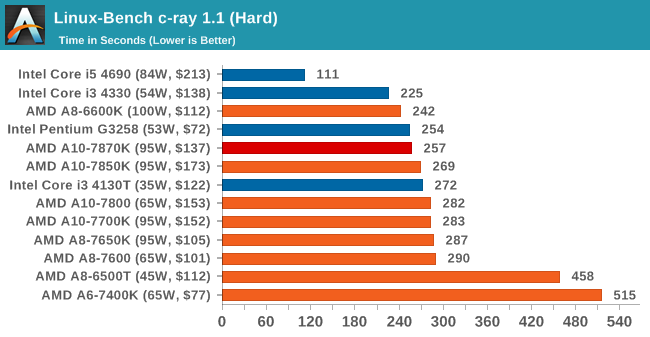
NAMD, Scalable Molecular Dynamics: link
Developed by the Theoretical and Computational Biophysics Group at the University of Illinois at Urbana-Champaign, NAMD is a set of parallel molecular dynamics codes for extreme parallelization up to and beyond 200,000 cores. The reference paper detailing NAMD has over 4000 citations, and our testing runs a small simulation where the calculation steps per unit time is the output vector.
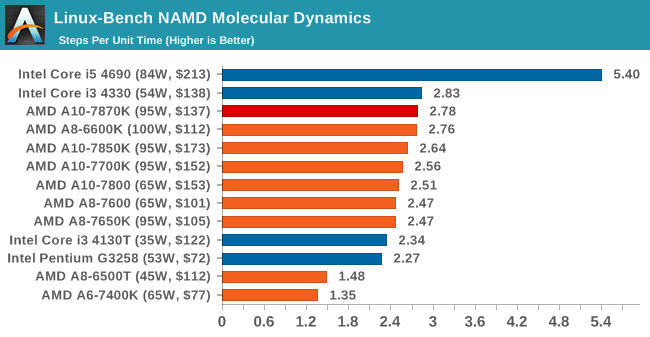
NPB, Fluid Dynamics: link
Aside from LINPACK, there are many other ways to benchmark supercomputers in terms of how effective they are for various types of mathematical processes. The NAS Parallel Benchmarks (NPB) are a set of small programs originally designed for NASA to test their supercomputers in terms of fluid dynamics simulations, useful for airflow reactions and design.
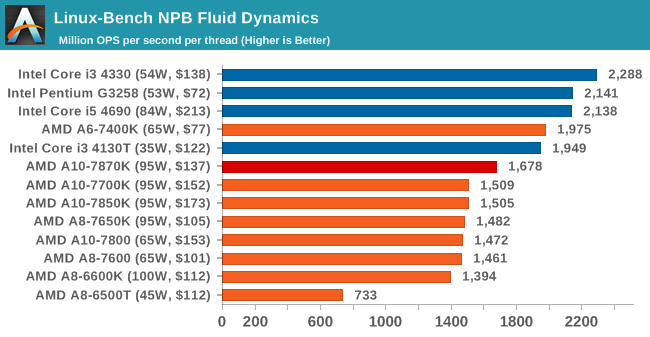
Redis: link
Many of the online applications rely on key-value caches and data structure servers to operate. Redis is an open-source, scalable web technology with a strong developer base, but also relies heavily on memory bandwidth as well as CPU performance.
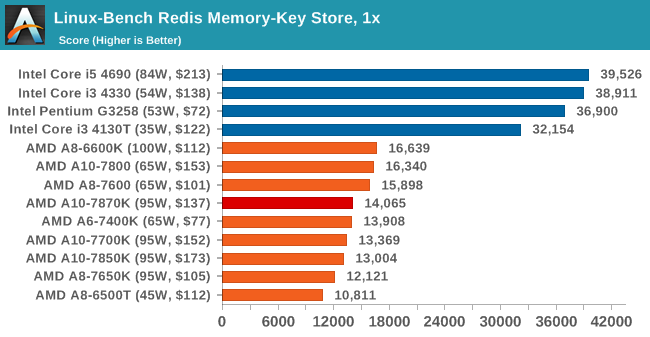

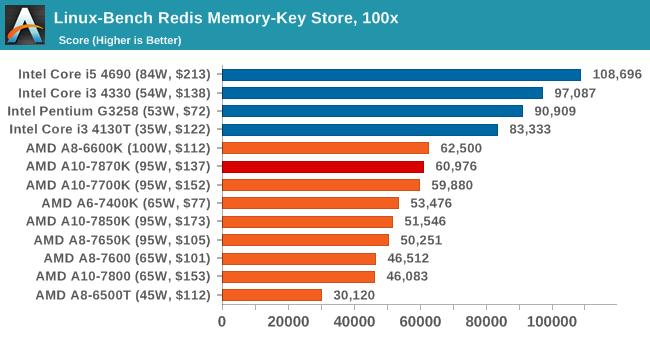










140 Comments
View All Comments
MrSpadge - Monday, June 1, 2015 - link
There are reports that this chip throttles back to 1600 MHz quickly after being loaded, only to jump up to a turbo mode for a short time and back to throttling again. This might due to unfinished pre-release bioses, but AMD certainly changed the performance tuning. And applies a mad voltage to this chip.silverblue - Monday, June 1, 2015 - link
Apparently, it was an early BIOS that caused the throttling, and as such has now been fixed.Valantar - Tuesday, June 2, 2015 - link
From what's being said in the forums, stock voltages for these chips are ludicrously high - in the 1.4-1.5V range! - causing all kinds of throttling and other odd behavior. From what's being said there, most Kaveri chips run just fine at stock speeds at~1.2V, so this overvolting is causing some real havoc in the test results. I would love to see AT look into this, at least for a bit, as it could cause some serious differences in both speed add power usage.tabascosauz - Tuesday, June 2, 2015 - link
The 7850K auto-throttles to 3.0GHz CPU-side whenever iGPU is pulling a lot of watts. It's a known issue that basically can't be fixed, probably because AMD is too paranoid about more ASRock A88X-ITXs blowing up under load. I wouldn't be surprised if the 7870K doesn't suffer from the same thing. The CPU speed boosts are always nonsense with Kaveri; the APU runs into its thermal envelope faster than you can say "throttling".Maybe AMD should start setting spec for VRM design. VRM design is the one killing AM3+, since MSI clearly doesn't know how to make them properly on that platform. FM2+, being the modern platform, shouldn't even have to address these problems (AMD should have made the necessary precautions), but it must if AMD wants to make any money.
Hobbitter - Friday, June 5, 2015 - link
I recieved a Asus crossblade ranger fm2+ and i had to send it back because of the VRM, they burnt my finger as soon as i touched them they were that hot. Plus it kept shutting my computer down even with a desk fan it would be red hot. could be a common problem with these APU's.Gigaplex - Monday, June 1, 2015 - link
I don't see how the conclusions match the test results. In many (arguably the majority) the new chip was bested by at least one other older AMD chip yet the conclusions of each segment pretty much state that the new chip is the clear winner. What?lefty2 - Monday, June 1, 2015 - link
You are correct. He says "almost all of our graphics tests saw a gain over the previous head of the Kaveri list".This is plainly not true. The test results show that Alien Isolation, Total War Attila and GRID autosport it's slower than 7850K. That's 3 out 5 games where it's slower! and it seems that most of the CPU tests it's slower than older Kavari CPUs.
jeffrey - Monday, June 1, 2015 - link
"I don't see how the conclusions match the test results. In many (arguably the majority) the new chip was bested by at least one other older AMD chip yet the conclusions of each segment pretty much state that the new chip is the clear winner. What?"Agree 100% !! All I could think of while reading the review was how bad AMD's scaling looked and how the 7870K was dominated by the 7850K. I figured I was going to get to a page somewhere in the review explaining why it trailed the outgoing chip so often and then bam, dat conclusion tho..
FriendlyUser - Monday, June 1, 2015 - link
Thanks for the review guys, much appreciated as I am considering one for my brother.nikaldro - Monday, June 1, 2015 - link
You're better of with a pentium + GTX750 in most cases